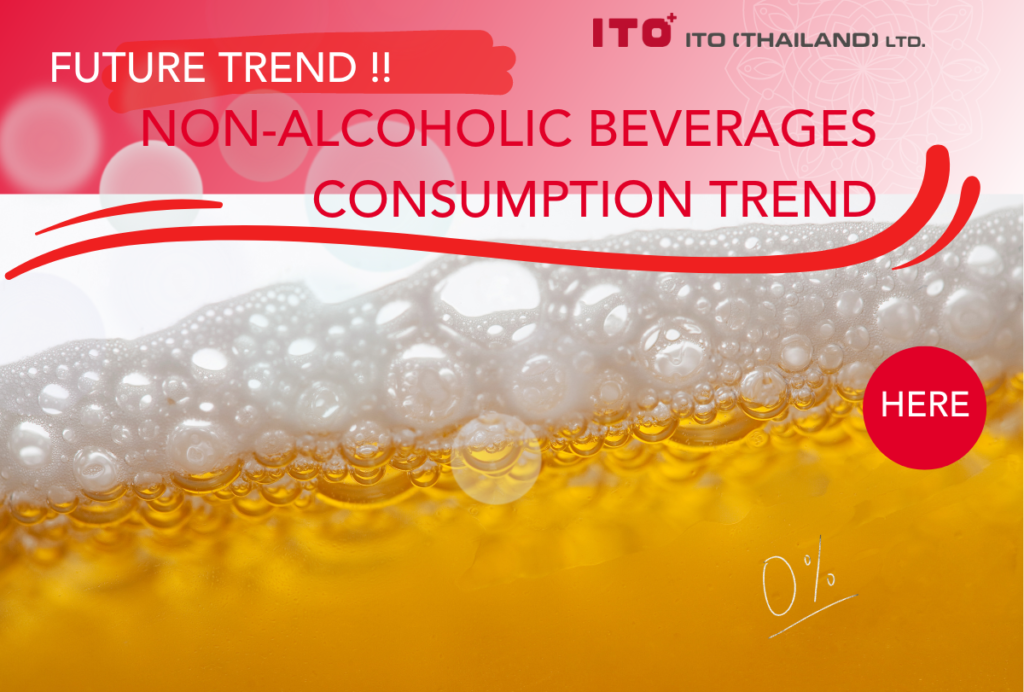ITO Thailand Hygiene Blog
0.0 Alcohol Beer
It is known that excessive consumption of alcoholic beverages is harmful and often leads to short-term health risks such as injuries, violence, alcohol poisoning, or unsafe sexual behaviour (2). Moreover, the development of chronic diseases such as high blood pressure, cardiovascular disease, cancer, mental health problems, and social problems are also related to the misuse of alcohol (2). So, young people have changed their drinks preference from beer or wine to low and no-ABV (alcohol by volume) drinks instead over the past years (4). In this blog, we will discuss non-alcoholic beverages consumption trends, introduction to zero-alcohol beer, its production technology, and future trends.
Non-alcoholic Beverages Consumption Trend
The main reasons why low and no-ABV beverages have received a high level of popularity are because drinkers have become aware of those harmful health risks, and some of them even admitted they had higher self-esteem and been more productive in everyday tasks when they stopped drinking (3). In the past, drinks were often used as a tool for socialising with other people, but now people can easily get to know each other by online social networks, so the necessity of alcoholic drinks has decreased (3). Even though some people confessed they are afraid of missing out, might have a limited social life, as well as an exclusion, they still prefer to not drink (3). Another reason is the rise of cafe culture, and coffees can be considered as a way of life for some people. It is reported that almost half (46%) of the Australian population are coffee drinkers, and 3 in 4 Australians have revealed they drink at least one cup of coffee per day (16).
Initially, ‘Dry January’, ‘Dry July’, or even ‘Sober September’ were the challenges for people who would like to take a break from alcohol during a period of time, however, after these alcohol-free months, they actually feel both of their physical and mental health have improved, so they determine to continue pause drinking and the rise in health consciousness have been perceived (9). We cannot deny the trend of alcoholic drinks with reduced alcohol content, with various flavours for ready-to-drink drinks as consumers prefer interesting, and new flavours as their first priority when purchasing their beverages, convenience such as cocktails to-go, and environmentally friendly and sustainable packaging (11).
What is 0.0 Alcohol Beer?
There are some differences between zero-alcohol beer and alcohol-free beer. ‘Alcohol-free’ beers usually contain a trace of alcohol from fermentation process, for instance, in the UK, drinks with 0.5% alcohol content are able to be labelled as ‘alcohol-free’ or ‘non-alcoholic’, but according to the USFDA regulation, 0.5% ABV (alcohol by volume) drinks are to be labelled as ‘trace amount of alcohol’ (1). 0.0 alcohol beer, or zero-alcohol beer is 100% alcohol-free beer and contains no trace of alcohol at all (6). It is suitable for people who are unable to consume alcohol, and also suitable for people who are on a ketogenic diet as they need to maintain a very small amount of carbohydrates (5). Consumers say they prefer an entirely alcohol-free beer because it has a similar taste to standard beer while being healthier, and lower in calories at the same time (7).
Production Technology
Numerous production technologies are available, with some examples such as:
1.Vacuum Distillation – This is the most popular method. Alcohol is heated until it evaporates with a lower boiling point under vacuum condition, so it prevents the deterioration of flavour compounds that usually have a higher boiling point than alcohol (8).
2.Reverse Osmosis or Membrane Filtration – It involves with the use of high pressure and heat to remove alcohol, with a better yield and flavour than a traditional thermal extraction because alcohol content is removed from filtrate, while flavour compounds are retained on the other side of the filter, then they are recombined later (8, 14, 17).
3.Cold Contact Fermentation (CCF) or Cold Contact Process (CCP) – This method can be used to produce low or 0.0 alcohol beer by the use of low temperature fermentation and an extended fermentation time (13).
Future Trends
As previously discussed, manufacturers are required to understand customers’ needs and prepare to produce innovative products. In 2023, demand for 0.0 alcohol beer is expected to grow, with $22 billion market value in 2022, companies such as AB InBev, and Heineken are launching new non-alcoholic beer (15). Non-alcoholic beer sales of Athletic Brewing have increased 70% over the last five years from an escalated number of health-conscious consumers, as well as alcohol consumption time is not limited to weekends anymore (12). We can see that an increase in popularity of 0.0 alcohol beer is huge, with a projected market value of $40 billion in 2033, doubling market size of $20 billion in 2023 (10).
We have discussed how the pandemic has impacted the food industry and witnessed the emergence of non-alcoholic. It is important to keep up with trends, in order to stay competitive in the food industry.
References
1.(2021). What’s the Difference Between 0.0 and 0.5 Proof? Deciphering Alcohol-Free and Nonalcoholic Drinks. Retrieved March 10, 2023, from https://boisson.co/blogs/news/what-s-the-difference-between-0-0-and-0-5-proof-deciphering-alcohol-free-and-nonalcoholic-drinks#:~:text=Here%20in%20the%20United%20States,alcoholic%20and%20never%20alcohol%2Dfree.
2.(2022). Alcohol Use and Your Health. Retrieved March 10, 2023, from https://www.cdc.gov/alcohol/fact-sheets/alcohol-use.htm
3.Conroy, D. (2020). Why young people are drinking less – and what older drinkers can learn from them. Retrieved March 10, 2023, from https://theconversation.com/why-young-people-are-drinking-less-and-what-older-drinkers-can-learn-from-them-133020
4.Cottong, A. (2021). 2022 Alcohol Trends: What Consumers are Drinking Now. Retrieved March 10, 2023, from https://get.doordash.com/en-us/blog/alcohol-trends
5.(2020a). Can you drink alcohol on the keto diet? Retrieved March 10, 2023, from https://www.delicious.com.au/drinks/article/can-you-drink-alcohol-keto-diet/mcjvobg4
6.(2020b). What is zero alcohol beer? Retrieved March 10, 2023, from https://www.delicious.com.au/drinks/beer/article/zero-alcohol-beer/h9g20j8p
7.(2023). Differences between alcoholic and non-alcoholic beers | Drinkaware. Retrieved March 10, 2023, from https://www.drinkaware.co.uk/facts/alcoholic-drinks-and-units/difference-between-alcoholic-and-alcohol-free-beers
8.Free Beer. (2022). How is Non Alcoholic Beer Made? | Free Beer. Retrieved March 10, 2023, from https://free-beer.co.uk/how-is-non-alcoholic-beer-made/
9.Fulton, A., & Aubrey, A. (2019). Breaking The Booze Habit, Even Briefly, Has Its Benefits. Retrieved March 10, 2023, from https://www.npr.org/sections/health-shots/2019/06/23/732876026/breaking-the-booze-habit-even-briefly-has-its-benefits
10.Jha, S. N. (2022). Non-Alcoholic Beer Market. Retrieved March 10, 2023, from https://www.factmr.com/report/4473/non-alcoholic-beer-market
11.Kerschbaumer, C. (2023). Alcoholic beverages: these are the trends in 2023. Retrieved March 10, 2023, from https://www.austriajuice.com/news-blog/alcoholic-beverages-trends
12.Morgan, D. (2022). A new trend is brewing: Nonalcoholic beers & mocktails. Retrieved March 10, 2023, from https://www.cbsnews.com/news/a-new-trend-is-brewing-nonalcoholic-beers-mocktails/
13.Pilarski, D. W., & Gerogiorgis, D. I. (2020). Progress and modelling of cold contact fermentation for alcohol-free beer production: A review. Journal of Food Engineering, 273, 109804. https://doi.org/10.1016/j.jfoodeng.2019.109804
14.Swiers, A. (2022). The 2 Ways Low-Alcohol Beer Is Manufactured. Retrieved March 10, 2023, from https://www.tastingtable.com/878446/the-2-ways-low-alcohol-beer-is-manufactured/
15.Thomas, I. (2022). Non-alcoholic beer to continue growing in 2023, Athletic Brewing Company CEO says. Retrieved March 10, 2023, from https://www.cnbc.com/2022/12/30/non-alcoholic-beer-set-to-continue-to-grow-in-2023.html
16.Unilever Food Solutions. (2023). The rise of coffee culture and new coffee trends. Retrieved March 10, 2023, from https://www.unileverfoodsolutions.com.au/chef-inspiration/cafe360/modern-menus/the-rise-of-coffee-culture-and-new-coffee-trends.html
17.Wong, M. (2023). Alcohol-Free Beer: How Is It Made? Retrieved March 10, 2023, from https://impossibrew.co.uk/blogs/journal/how-its-made-alcohol-free-beer
Related Post
-

Food Safety Culture
Food safety culture plays a crucial role in safeguarding the company's reputation, ensuring the well-being of its employees, and providing a safe experience for its customers.
-

New food source safety issues
What are safety issues worth knowing for trendy new food sources like plant-based and insect-based proteins?
-

British Retail Consortium (BRC) Standard
Food safety management systems play a vital role in ensuring the production and distribution of safe and high-quality food products to consumers. With the global food supply chain becoming increasingly complex, food businesses must implement effective systems prioritising safety, quality, and compliance with industry standards. A food safety management system encompasses a set of procedures, processes, and controls designed to identify, prevent, and manage potential hazards at every stage of the food production and supply process. This proactive approach not only safeguards consumers' health but also protects the reputation and credibility of food companies in an ever more competitive market.
-

Food Science in the World of Food Gastronomy (Part 1)
How can food science be applied to create new dishes?
-

FSSC 22000
Food manufacturers must ensure food safety standards and processes. FSSC 22000 is an official certification program for Food Safety Management Systems (FSMS) recognised by the Global Food Safety Initiative (GFSI). This certification scheme offers a set of guidelines and procedures to ensure uniformity, openness, and safety across your entire supply chain. It applies to all companies operating within the food and beverage industry, ranging from farmers to retailers. By fulfilling the necessary criteria and obtaining FSSC 22000 certification, it is demonstrated that the required standards for food quality and implementing effective processes to manage and mitigate risks associated with food fraud, foodborne illnesses, expensive recalls, and other external threats are met.
-

Food Safety Aspects of Artificial Sweeteners
Artificial sweeteners, also known as sugar substitutes, non-nutritive sweeteners, or high-intensity sweeteners, are artificially produced compounds utilised in place of sucrose (table sugar) to add sweetness to food and drinks. Due to their significantly higher sweetness than regular sugar, only a fraction of artificial sweeteners (200 to 20,000 times less) is required to achieve an equivalent level of sweetness. Since the caloric contribution of these sweeteners, when used in such small quantities, is insignificant, they are often referred to as non-nutritive (4).










